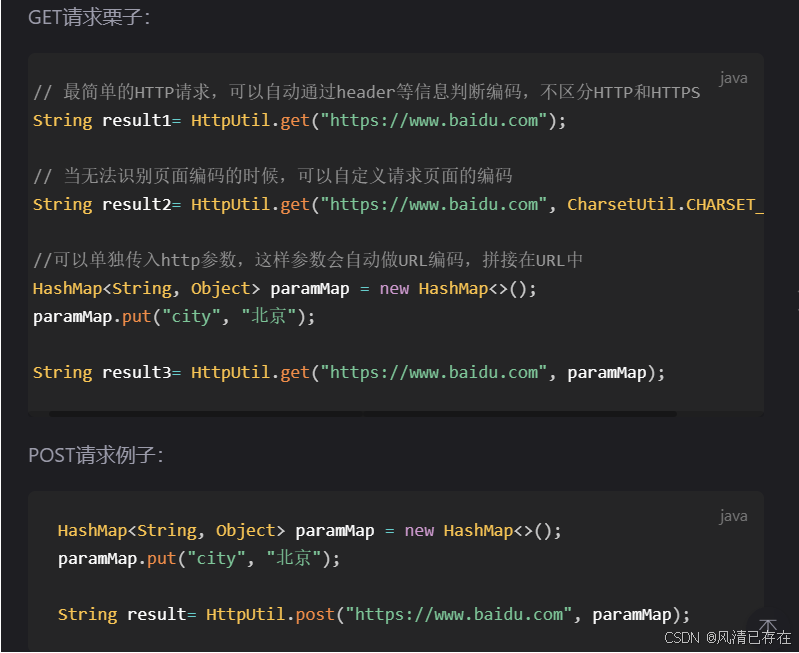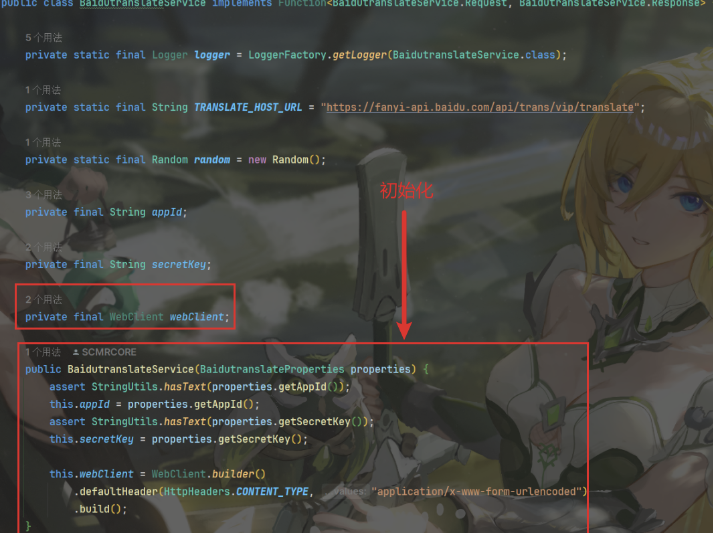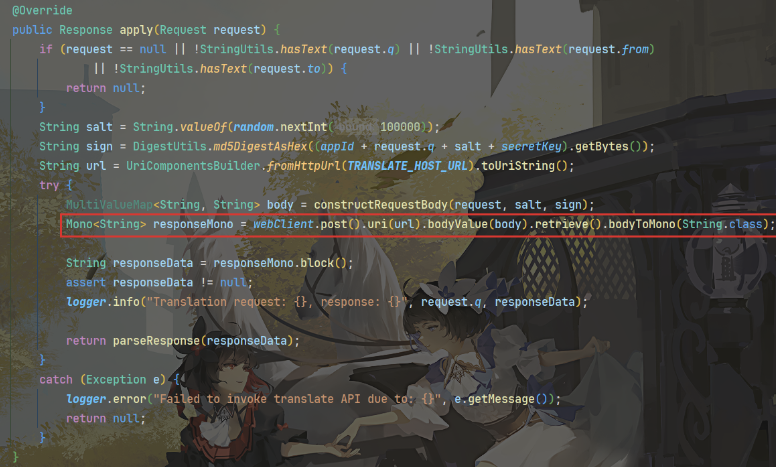HttpClient
具体介绍
1.介绍
HttpClient 是Apache Jakarta Common 下的子项目,可以用来提供高效的、最新的、功能丰富的支持 HTTP 协议的客户端编程工具包,并且它支持 HTTP 协议最新的版本和建议。
2.功能
- 实现了所有 HTTP 的方法(GET、POST、PUT、HEAD、DELETE、HEAD、OPTIONS 等)
- 响应数据
3.使用场景
需要调用其他系统接口时,尤其是基于HTTP协议的接口
例如:微信支付、查看地图、获取短信验证码、获取天气
4.核心api
HttpClient:Http客户端对象,使用该类型对象可发起Http请求。(接口)
HttpClients:构建器,用于获得HttpClient对象。
CloseableHttpClient:具体实现类,实现了HttpClient接口。
HttpGet:Get方式请求类型。
HttpPost:Post方式请求类型。
5.请求发送步骤
- 创建HttpClient对象
- 创建Http请求对象(比如我们要发送一个get请求,我们就需要构造HttpGet对象)
- 调用HttpClient的execute对象方法发送请求
使用步骤
1.引入依赖
xml
<dependency>
<groupId>org.apache.httpcomponents</groupId>
<artifactId>httpclient</artifactId>
<version>4.5.13</version>
</dependency>2.原始请求方法(不推荐)
Get请求:
java
//通过httpclient发送GET方式的请求
@Test
public void testGET() throws IOException {
//创建httpclient对象
CloseableHttpClient httpClients = HttpClients.createDefault();
//创建请求对象
HttpGet httpGet = new HttpGet("http://localhost:8080/user/shop/status");
//发送请求对象,并接受响应结果
CloseableHttpResponse response = httpClients.execute(httpGet);
//获取服务端返回回来的状态码
int statusCode = response.getStatusLine().getStatusCode();
System.out.println("服务端返回的状态码: " +statusCode);
//获取服务端返回回来的响应体,然后通过一个工具类来解析这个响应体
HttpEntity entity = response.getEntity();
String body = EntityUtils.toString(entity);
System.out.println("服务端返回的数据是: " +body);
response.close();
httpClients.close();
}Post请求:
java
@Test
//通过httpclient发送POST方式的请求
public void testPOST() throws IOException {
//创建httpclient对象
CloseableHttpClient httpClient = HttpClients.createDefault();
//创建请求对象
HttpPost httpPost = new HttpPost("http://localhost:8080/admin/employee/login");
JSONObject jsonObject = new JSONObject();
jsonObject.put("username","admin");
jsonObject.put("password","123456");
StringEntity entity = new StringEntity(jsonObject.toString());
//指定编码方式
entity.setContentEncoding("utf-8");
//数据格式
entity.setContentType("application/json");
// post请求设置请求参数(JSON格式)
httpPost.setEntity(entity);
//发送请求
CloseableHttpResponse response = httpClient.execute(httpPost);
//解析返回结果
//获取服务端返回回来的状态码
int statusCode = response.getStatusLine().getStatusCode();
System.out.println("服务端返回的状态码: " +statusCode);
//获取服务端返回回来的响应体,然后通过一个工具类来解析这个响应体
HttpEntity entity1 = response.getEntity();
String body = EntityUtils.toString(entity1);
System.out.println("服务端返回的数据是: " +body);
//关闭资源
response.close();
httpClient.close();
}3.工具类(推荐)
例子:

源码:
java
/**
* Http工具类
*/
public class HttpClientUtil {
static final int TIMEOUT_MSEC = 5 * 1000;
/**
* 发送GET方式请求
* @param url
* @param paramMap
* @return
*/
public static String doGet(String url,Map<String,String> paramMap){
// 创建Httpclient对象
CloseableHttpClient httpClient = HttpClients.createDefault();
String result = "";
CloseableHttpResponse response = null;
try{
URIBuilder builder = new URIBuilder(url);
if(paramMap != null){
for (String key : paramMap.keySet()) {
builder.addParameter(key,paramMap.get(key));
}
}
URI uri = builder.build();
//创建GET请求
HttpGet httpGet = new HttpGet(uri);
//发送请求
response = httpClient.execute(httpGet);
//判断响应状态
if(response.getStatusLine().getStatusCode() == 200){
result = EntityUtils.toString(response.getEntity(),"UTF-8");
}
}catch (Exception e){
e.printStackTrace();
}finally {
try {
response.close();
httpClient.close();
} catch (IOException e) {
e.printStackTrace();
}
}
return result;
}
/**
* 发送POST方式请求
* @param url
* @param paramMap
* @return
* @throws IOException
*/
public static String doPost(String url, Map<String, String> paramMap) throws IOException {
// 创建Httpclient对象
CloseableHttpClient httpClient = HttpClients.createDefault();
CloseableHttpResponse response = null;
String resultString = "";
try {
// 创建Http Post请求
HttpPost httpPost = new HttpPost(url);
// 创建参数列表
if (paramMap != null) {
List<NameValuePair> paramList = new ArrayList();
for (Map.Entry<String, String> param : paramMap.entrySet()) {
paramList.add(new BasicNameValuePair(param.getKey(), param.getValue()));
}
// 模拟表单
UrlEncodedFormEntity entity = new UrlEncodedFormEntity(paramList);
httpPost.setEntity(entity);
}
httpPost.setConfig(builderRequestConfig());
// 执行http请求
response = httpClient.execute(httpPost);
resultString = EntityUtils.toString(response.getEntity(), "UTF-8");
} catch (Exception e) {
throw e;
} finally {
try {
response.close();
} catch (IOException e) {
e.printStackTrace();
}
}
return resultString;
}
private static RequestConfig builderRequestConfig() {
return RequestConfig.custom()
.setConnectTimeout(TIMEOUT_MSEC)
.setConnectionRequestTimeout(TIMEOUT_MSEC)
.setSocketTimeout(TIMEOUT_MSEC).build();
}
}WebClient
也是用于发送api请求的工具
路径:
java
import org.springframework.web.reactive.function.client.WebClient;用法示例:
注入与初始化

发送请求
